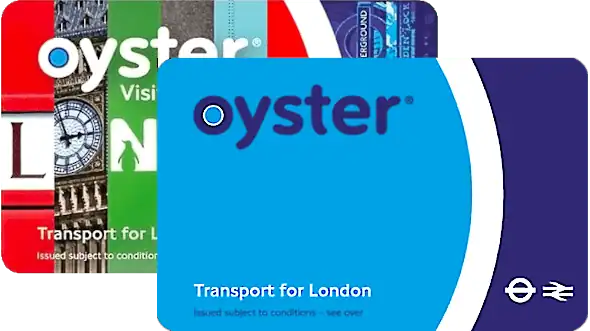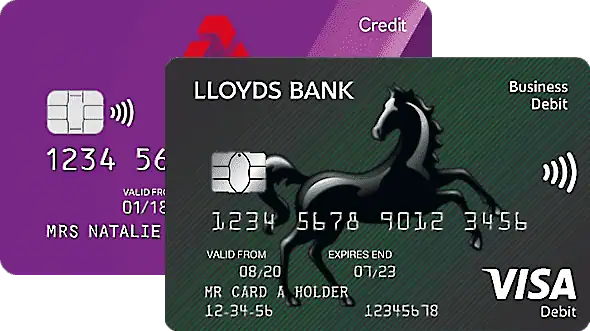
Which card should you choose?
One of the first decisions that a tourist has to make when travelling around London is whether to use an Oyster card, contactless card or travelcard.
The first thing to be aware of is that using cash to buy individual tickets is definitely the worst idea, as single tickets on the train are more than double the cost of Oyster and contactless, and you can’t even buy single tickets on the bus anyway. So which of the three cards do we recommend?
Oyster cards

An Oyster card is a credit card-sized piece of plastic. You load it up with money before you travel and then tap it down on the Oyster card readers on the buses and trains. The computer will then automatically deduct the correct fare from your credit. When you start running low on credit you can just top it up again at a ticket machine.
They come in two different types: normal blue Oyster cards are aimed primarily at the locals, whereas Visitor Oyster cards are aimed primarily at the tourists (although they are basically both the same, so it doesn’t really matter which one you get).
What are the benefits of using an Oyster card?
- The biggest benefit of using an Oyster card is its joint cheapest fares for single journeys (along with contactless)
- The Oyster daily cap is always cheaper than buying a 1-day travelcard
- Oyster pay-as-you-go credit can be used in zones 1-9, whereas travelcards are only valid in the zones you buy them for
- If you register your card online then you can turn on the ‘auto top-up’ feature which takes money out of your bank account whenever your credit gets low, so you don’t have to worry about running out
- Pay-as-you-go credit never expires, so you can carry on using any leftover credit on your next visit
- Visitor Oyster cards also come bundled with a book of discounts vouchers which can save you money at shops, restaurants and entertainment venues. These discounts are constantly changing all the time, but in the past they’ve included things like 10% off a boat ride, 10% off souvenirs in a particular gift shop, or 20% off a meal in a particular restaurant. The instructions for each venue will come with the vouchers, but most of the time all you have to do is show your Visitor Oyster card when you pay the bill, and the staff will apply the discount
What are the downsides of using an Oyster card?
- One of the downsides of using an Oyster card is that you can’t pay two fares with one card, so each traveller in your group will need their own
- The weekly cap only works from Monday to Sunday, whereas weekly travelcards can start on any day of the week you like
- You have to pay a £7 deposit whenever you buy a new Oyster card, or a £7 activation fee when you buy a Visitor Oyster card, which can’t be put towards fares
- You can’t buy a Visitor Oyster card in central London, only the normal blue Oyster cards. If you want a Visitor Oyster card then you have to buy it online in advance and have it posted to you
Contactless cards

A contactless payment card is just your normal everyday debit or credit card. It works in exactly the same way as a London Oyster card. You just tap it down on the Oyster card readers on the buses and trains and the computer will automatically deduct the correct fare from your bank account.
What are the benefits of using a contactless card?
- One of the main benefits of using a contactless card is that it’s just your normal everyday bank card or credit card, so you probably already have one
- Contactless also has the joint cheapest fares for single journeys (along with Oyster)
- The contactless daily cap is always cheaper than buying a 1-day travelcard
- Contactless can be used in zones 1-9, whereas travelcards are only valid in the zones you buy them for
- Unlike Oyster cards, you don’t have to pay a £7 deposit to set it up
- Unlike Oyster cards, there’s no need to keep topping it up with credit because the money comes straight from your bank account
- Contactless cards can be used in conjunction with Mobile Pay on your phone
What are the downsides of using a contactless card?
- One of the downsides of using a contactless card is that you can’t pay two fares with just one card, so each traveller in your group will need their own
- The weekly cap only works from Monday to Sunday, whereas weekly travelcards can start on any day of the week you like
- Unlike with Oyster, you can’t load a travelcard onto a contactless card
- Not all foreign-issued cards are accepted, and foreign cards might have a transaction fee added on by your bank every time you buy a ticket, bumping up the price of your journey
Travelcards

Travelcards are credit card-sized pieces of paper. They can also be loaded onto an Oyster card. You choose the duration you want it to cover (either 1-day, one week, one month or one year), whether you want it to cover just the bus/tram, or the train/bus/tram together, plus the zones you want to travel through, and then you’ll be entitled to unlimited travel in those zones until it expires.
What are the benefits of using a travelcard?
- The biggest benefit of using a travelcard is that you can make an unlimited number of journeys over one day, one week, one month or one year
- Depending on how many journeys you make in total, a weekly travelcard might work out cheaper than the Oyster and contactless weekly cap
- Unlike Oyster cards, you don’t have to pay a £7 deposit the first time you buy it
- You can take advantage of National Rail’s 2-for-1 offer to get cheap entry into 150+ tourist attractions. All you have to do is print out the relevant voucher from daysoutguide.co.uk/2for1-london and then hand it over at the attraction, alongside a valid National Rail travelcard for the same day of travel. But here’s the catch: the travelcard has to be printed on orange paper. That means that you have to buy it from a National Rail station (the big overground hubs like Euston, King’s Cross, Liverpool Street, Paddington, Victoria and Waterloo). Travelcards bought at London Underground stations are no good, because they will be printed on TFL’s pink paper. And travelcards loaded onto an Oyster card are no good either
What are the downsides of using a travelcard?
- One of the downsides of using a travelcard is that you can’t share one between two people, so each person in your group will need their own
- One day travelcards are always more expensive than the daily cap on Oyster and contactless
- Unlike the pay-as-you-go-credit on Oyster and contactless cards, travelcards can only be used in the zones you bought it for. If you later decide that you want to travel outside of those zones then you’ll have to buy a completely separate ticket
- Travelcards are only valid for 1-day, one week, one month or one year – you can’t buy a travelcard that covers any other stretch of days
How do Oyster, contactless and travelcard fares compare?
| Bus & Tram only | One day | Week | Month |
|---|---|---|---|
| All zones | |||
| Oyster & Contactless | £5.25 | £24.70 | n/a |
| Travelcard | £6 | £24.70 | £94.90 |
| Train, Bus & Tram | One day | Week | Month | |
|---|---|---|---|---|
| Peak | Off-peak | |||
| Zone 1-2 | ||||
| Oyster & Contactless | £8.90 | £8.90 | £44.70 | n/a |
| Travelcard | n/a | n/a | £44.70 | £171.70 |
| Zone 1-3 | ||||
| Oyster/ Contactless | £10.50 | £10.50 | £52.50 | n/a |
| Travelcard | n/a | n/a | £52.50 | £201.60 |
| Zone 1-4 | ||||
| Oyster & Contactless | £12.80 | £12.80 | £64.20 | n/a |
| Travelcard | £16.60 | n/a | £64.20 | £246.60 |
| Zone 1-5 | ||||
| Oyster & Contactless | £15.30 | £15.30 | £76.40 | n/a |
| Travelcard | n/a | n/a | £76.40 | £293.40 |
| Zone 1-6 | ||||
| Oyster & Contactless | £16.30 | £16.30 | £81.60 | n/a |
| Travelcard | £23.60 | £16.60 | £81.60 | £313.40 |
| Zone 1-9 | ||||
| Oyster & Contactless | £23.30 | £16.30 | £116.40 | n/a |
| Travelcard | £29.80 | £17.80 | £116.40 | £447 |
| Note: Prices are correct as of | ||||
Bear in mind that travelcards only allow you to travel between a set period (either one day, one week, one month or one year), whereas the Oyster daily cap and contactless daily cap apply all the time.
You can think of the daily cap as a price ceiling – it doesn’t matter how many buses or trains you ride each day, the maximum amount that the computer will take from your Oyster or contactless card will never rise above the cap.
Peak and off-peak fares – For Oyster and contactless peak fares apply to all journeys that start between 6:30 AM and 9.30 AM (Monday to Friday), or 4 PM and 7 PM (Monday to Friday). It doesn’t matter what time the journeys finish. Any other journey is classed as off-peak.
For travelcards, off-peak applies to any journey that starts after 9.30 AM (Monday to Friday).
Which is the cheapest: Oyster, contactless or travelcard?
The Oyster and contactless cap is always cheaper than buying a one day travelcard… but bear in mind that you also have to pay an £7 deposit on top the first time you buy an Oyster card, so a 1-day travelcard can still work out as better value.
The Oyster and contactless weekly cap is identical to buying a weekly travelcard, but you need to make enough journeys to make a weekly travelcard worthwhile. If you make at least three or more journeys on six days, or two or more journeys on seven days, then a 7 day travelcard will be worth it, otherwise you should go for an Oyster card or contactless instead.
How long do Oyster, contactless and travelcards last?
The pay-as-you-go credit on an Oyster card lasts forever. If you don’t use all the money up during your first holiday then you can simply carry on using it during your next visit.
Contactless cards don’t expire either, because they take the money straight out of your bank account.
A travelcard is the only one with an actual expiry date, because you have to choose a start date and duration when you buy it – either one day, one week, one month or one year. Once the duration has passed then the travelcard will stop working.
Where can you use Oyster, contactless and travelcards?
Buses – Oyster cards, contactless cards and travelcards can be used on TFL buses all over London. And because buses don’t have zones you can use a train/bus/tram travelcard in whichever zone you like, regardless of which zones you actually bought it for.
London Underground, London Overground, DLR, TFL Rail, National Rail – The pay-as-you-go credit on Oyster cards and contactless can be used in all of the Oyster zones (1-9), but travelcards can only be used in the zones you bought it for.
You can also use Oyster and contactless on the Heathrow and Gatwick Express, but bear in mind that it won’t count towards the daily cap – it will just be deducted from your credit.
Taxis – Contactless cards can also be used to pay for black cabs (assuming that the fare is less than the current limit of £100). But Oyster cards and travelcards cannot.
IFS Cloud Cable Car & Thames Clipper – You can use Oyster cards and contactless to pay for a ticket on the cable car and Uber’s Thames Clipper service, but bear in mind that the cost will not count towards the daily cap – it will just deduct the relevant fare from your credit. Travelcards cannot be used to pay the fare.
Which is best: Oyster, contactless or travelcard?
So which is better? If you’re a foreign visitor coming to London for just one day then we recommend choosing a one day travelcard. The Oyster and contactless daily cap might seem cheaper, but when you factor in the Oyster card’s £7 deposit, and the fact that your bank might add on a transaction fee every time you use a foreign bank card overseas, then a travelcard will likely work out cheaper.
If you’re a foreign visitor coming to London for more than one day then we recommend buying an Oyster card or Visitor Oyster card instead… unless you’re planning on making two or more journeys on seven consecutive days, or three or more journeys on six of those days, in which case a weekly travelcard will work out cheaper.
If you’re a UK visitor then we always recommend using your contactless card, regardless of how many days you’re staying, because the fares are the same as Oyster and you don’t have to pay a deposit to get one.
 Twitter
Twitter Facebook
Facebook Bluesky
Bluesky WhatsApp
WhatsApp Email
Email
